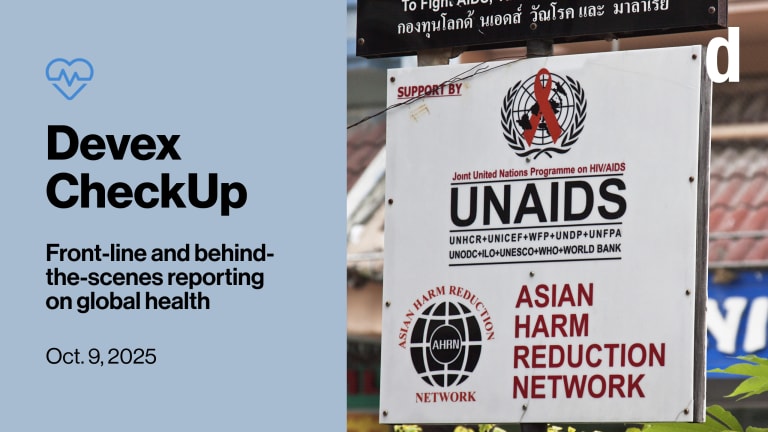How to break the glass ceiling from global health pros who've done it
Devex speaks to several global health leaders about their career journeys and what it will take to shatter the glass ceiling in global health, especially for women from low- and middle-income countries.
For women working in global health — and in development more broadly — accessing leadership positions and the C-suite has long been an uphill struggle. A recent report from Women in Global Health highlights just how large and far-reaching the disparities are for women leaders in the health field. The State of Women and Leadership in Health report reveals that while women hold around 70% of health worker jobs globally, they only account for 25% of senior leadership roles in the sector. And not all groups of women are equally represented among the few that have managed to shatter the glass ceiling, with women from low- and middle-income countries particularly missing in global health leadership. According to data from 50/50 Global Health, only 5% of leadership roles in health are held by women from LMICs. When Sekai Chikowero — now the vice president of programs at the nonprofit EngenderHealth based in Washington, D.C. — was a country director in the early 2000s in her native Zimbabwe and later in Tanzania, she could count the Black country directors heading international NGOs: “On one hand and not even finish all the fingers … never mind being a female African country director. It was just so rare.” “At the time when I became a country director it was an exclusively expatriate role — we were actually called third-country nationals,” she explained. “And it wasn’t just the label that was different — the expatriate jobs came with different privileges and status, even though we were doing similar work.” While localization efforts are driving some change, Dr. Sai Subhasree Raghavan — the president of India-based SAATHII, an organization advancing access to health and social services for marginalized communities — questions the concept of global health itself. “We talk about global health but the majority of the leadership positions are not held by women or men from resource-poor settings. And so I question the definition of global health itself.” “We always force women to lead like men, and I think we should stop that. … We need to recognize that women have different leadership styles.” --— Dr. Sai Subhasree Raghavan, president, SAATHII As highlighted in an op-ed published by Devex earlier this year, only one of the 13 most influential players in global health is led by a woman from an LMIC — Winnie Byanyima at UNAIDS. Meanwhile, the likes of the World Health Organization, the Global Fund to Fight AIDS, Tuberculosis and Malaria, Gavi, the Vaccine Alliance, and UNICEF are all led by men or women from high-income countries. Devex spoke to several global health leaders about their career journeys and what it will take to bring more equity to the leadership ranks of global health organizations, especially for women from LMICs. Embrace gender-transformative leadership “We need to focus on fixing systems, not women,” said Dr. Roopa Dhatt, executive director and co-founder of Women in Global Health. Her organization advocates for gender transformative leadership and calls on leaders to intentionally promote gender transformative policies within their organizations and to build equity in their workforce and decision-making roles. “For women, the approach that is often used is mentorship. And it's really focused on women having to fix themselves to fit into systems that were not designed for them. So they're given assertiveness training, negotiating training, and are being urged to lean in and create opportunities to be visible so they will be selected for leadership roles,” said Dhatt. While these strategies might create one-time opportunities, they aren’t leading to women climbing to the highest leadership roles, she explained. While it’s important to have role models and for women to be visible in leadership roles, Dhatt believes it’s not enough for a few women to climb the ranks. “We really need to reach a 30% tipping point to start making a difference and open up opportunities.” “From time to time the imposter syndrome raises its ugly head and plants doubt into my mind. And it limits even my own initiative in terms of getting myself resources.” --— Sekai Chikowero, vice president of programs, EngenderHealth Networks lead to connections that lead to jobs Before enrolling in Harvard’s LEAD Fellowship promoting women leaders in global health, Subhasree Raghavan didn’t realize that the networks that men have — and the benefits they receive from them — weren’t accessible to women. “Coming from a developing country, I certainly didn’t privilege from these networks, and I probably would have benefited more if I was part of them.” If you’re not in a network, nobody will know you or what you’re capable of, explained Ama Pokuaa Fenny, a senior research fellow at the Institute of Statistical, Social, and Economics Research at the University of Ghana and and a commissioner for the Africa COVID-19 commission. “What I’ve seen work is intentionally inviting women to apply for open leadership roles because if they're not part of the networks it’s so difficult to be seen or heard.” Women in Global Health is working to encourage women’s networks to put forward women for top roles at the national level. They also inform the women in their network of any big, global positions opening up. “We are constantly in our network asking ‘Who's looking for the next opportunity?’ and even if someone's not looking, we are encouraging them to take that next step,” said Dhatt. Providing leadership training In global health organizations, staffers are normally recruited for their technical expertise and then promoted to leadership positions over time as they excel technically, explained EngenderHealth’s Chikowero. “That's the road I traveled, with no training, with no access to resources for leadership and management. You wake up in a management role with no preparation to be a manager, and you're expected to manage,” she said. “So the opportunity for me to access training and to be a manager is very limited, especially for leaders from the global south.” Men don’t face the same issue as they have more access to social networks and can seek mentorship from like-minded men who help them grow, she added. “From time to time the imposter syndrome raises its ugly head and plants doubt into my mind. And it limits even my own initiative in terms of getting myself resources — even in spaces where I'm supposed to be able to access those resources,” said Chikowero. But it doesn’t mean women should be expected to adopt the same leadership style as men. “We always force women to lead like men, and I think we should stop that,” according to Subhasree Raghavan. “We need to recognize that women have different leadership styles and nurture those differences instead of emulating men.” Addressing the ‘motherhood penalty’ The Women in Global Health report, which includes case studies from India, Nigeria, and Kenya, also revealed that women — regardless of which country they were in — faced gender bias and weren’t able to access the most senior high-level positions. This was often driven by the perception of the so-called motherhood penalty, explained Dhatt. Regardless of whether women have children or not, it is perceived that they will have to fulfill that role at some point, and therefore, they aren’t given the same level of investment into career opportunities — that’s the motherhood penalty. One proven policy that can help overcome some of these barriers is quotas and all-women shortlists. So that whenever a new role opens up, this time around, you make sure it’s going to a woman, explained Dhatt. “We need to be comfortable with radical solutions to break the glass ceiling.” Update, May 2, 2023: This piece has been updated to reflect the correct title and affiliation of Ama Pokuaa Fenny. Ready to stand out from the crowd and get noticed by the recruiters who matter most? Update your Devex profile and start connecting with top global development recruiters now.
For women working in global health — and in development more broadly — accessing leadership positions and the C-suite has long been an uphill struggle. A recent report from Women in Global Health highlights just how large and far-reaching the disparities are for women leaders in the health field.
The State of Women and Leadership in Health report reveals that while women hold around 70% of health worker jobs globally, they only account for 25% of senior leadership roles in the sector.
And not all groups of women are equally represented among the few that have managed to shatter the glass ceiling, with women from low- and middle-income countries particularly missing in global health leadership. According to data from 50/50 Global Health, only 5% of leadership roles in health are held by women from LMICs.
This article is exclusively for Career Account members.
Unlock this article now with a 15-day free trial of a Devex Career Account. With a Career Account subscription you will get:
- Full access to our jobs board, including over 1,000 exclusive jobs
- Your Devex profile highlighted in recruiter search results
- Connections to recruiters and industry experts through online and live Devex events
Start my 15-day free trialAlready a user?
Printing articles to share with others is a breach of our terms and conditions and copyright policy. Please use the sharing options on the left side of the article. Devex Pro members may share up to 10 articles per month using the Pro share tool ( ).
Natalie Donback is a freelance journalist and editor based in Barcelona, where she covers climate change, global health, and the impact of technology on communities. Previously, she was an editor and reporter at Devex, covering aid and the humanitarian sector. She holds a bachelor’s degree in development studies from Lund University and a master’s in journalism from the University of Barcelona and Columbia Journalism School.








